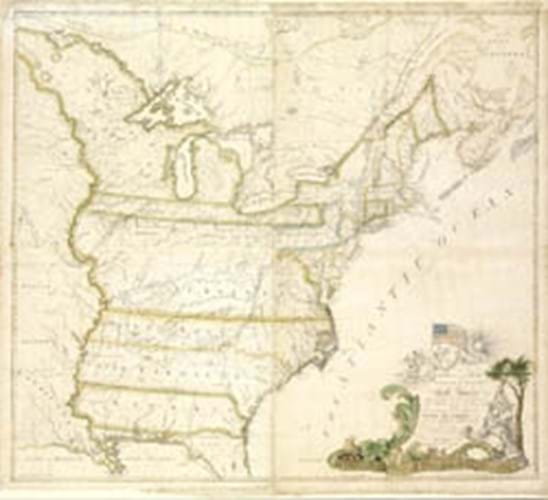
His is not a name that springs readily to mind when considering the great names of cartography, but, at the sale on December 2, a copy of the monumental, four-sheet wall-map, sold at $1.8m (£1.15m) plus premium to an American collector.
Buell's depiction of the newly independent nation was the first to be printed in the United States and, in its title cartouche, the first to include the Stars and Stripes. It is in fact a map of many firsts, but is known in only a handful of copies, all of them in institutional collections.
This was the first time that his historic and opportunistic map had ever been seen at auction.
As a young man, Abel Buell was branded and had his ear cropped for counterfeiting coinage. After a tumultuous, up-and-down career of invention and bad business choices, he ended his life in the New Haven Almshouse.
The young Buell gained early notoriety in his native Connecticut when, in 1764, he was found guilty of counterfeiting coins and received the mandatory sentence of imprisonment, cropping or branding - though it seems his punishment was carried out with restraint. State records tell us only the top of his ear was cropped off, and he kept it warm on his tongue until it was possible to replace it and let it grow back! The branding was carried out, but the letter indicating his crime was burnt onto his forehead as high as possible.
Described by his only biographer as "a restless, unstable, inventive genius", Buell was apprenticed as a silversmith but also worked as an engraver and typefounder, in which latter field he was the first in America. He invented a machine for grinding and polishing precious stones and, somewhat ironically, given his early misdemeanours, one of his first post-revolutionary ventures was to cast the State of Connecticut's first pennies on a minting machine of his own manufacture.
In the decorative arts world, Buell's name may be familiar to some as a silversmith, but it is the map that he put together as yet another of his speculative ventures for which he will be longest remembered. Buell cleverly drew on and synthesized the work of earlier mapmakers. His key sources were the celebrated Mitchell and Lewis Evans maps of 1755 (the former being the map actually used in negotiations at the Treaty of Peace), but he also borrowed from Thomas Hutchins' map of the Trans-Allegheny region and Jonathan Carver's map of his explorations of the Great Lakes and Mississippi.
Buell took a few liberties - running the prime meridian through Philadelphia rather than London, for example - and, taking advantage of the fact that state borders were still highly confused and poorly established at this time, he showed his own home state of Connecticut with its borders reaching as far west as the Mississippi. New York state is swallowed up by the great Connecticut landmass and not even named on the map.
William McMurray had, in August 1783, already proposed a new map of the new United States, but a manuscript version of his 'United States according to the Definitive Treaty of Peace', displayed in the Philadelphia Coffee House, was slow to attract subscribers and Buell, who had the advantage of being his own printer, was first to publish. It was not until 1924 that the Library of Congress, which does not own a copy, acknowledged Buell, not MacMurray, as producing the first map of the US.
The copy at Christie's was consigned by the New Jersey Historical Society, to whom it had been given in 1862 by Senator William L. Dayton of New Jersey who, whilst serving as Lincoln's Minister Plenipotentiary in Paris, had come across it on one of his frequent excursions to the city's book and print stalls.
Despite some chipping around the margins, it is one of the best-preserved of the seven recorded copies, largely because it was unvarnished and had lain undisturbed for almost 100 years.
The buyer's premium was 25/20/12%.
By Ian McKay




